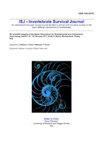The influence of surface waters on the bioavailability and toxicity of copper oxide nanoparticles to freshwater mussels
IF 1.2
4区 农林科学
Q4 IMMUNOLOGY
引用次数: 0
Abstract
The increased commercial use of copper oxide nanoparticles (nCuO) led to the release of nanoparticles in wastewaters potentially harming the aquatic biota. The purpose of this study was to determine the toxic action of nCuO and dissolved Cu (II) to Dreissena bugensis freshwater mussels placed in 4 types of surface waters: aquarium, green (high conductivity), brown (high organic carbon) and 10 % municipal effluent (high conductivity and anthropogenic source of organic carbon). Mussels were exposed to 50 µg/L of nCuO or Cu (II) for 96 h at 15 °C in the above waters. The results revealed that the total Cu loadings were higher in mussels placed in organic-rich waters (brown and effluent) and exposed to either forms of Cu. Tissue Cu contents were correlated with air-time survival, lipid peroxidation, protein-ubiquitin levels and DNA strand breaks. Both surface water types and Cu forms influenced Zn (II) mobilization, glutathione S-transferase activity and protein turnover (ubiquitin binding). Based on the surface water properties, Cu (II) was more influenced by the levels and origin of the organic carbon content while nCuO was more influenced by the total suspended solids. In conclusion the toxicity of nCuO could be influenced by surface waters properties expecially when similar physiological targets are impacts by these treatments.地表水对氧化铜纳米颗粒对淡水贻贝的生物利用度和毒性的影响
氧化铜纳米颗粒(nCuO)的商业使用增加,导致废水中纳米颗粒的释放可能危害水生生物群。本研究的目的是确定nCuO和溶解的Cu (II)对放置在4种地表水中的淡水贻贝的毒性作用:水族馆、绿色(高导电性)、棕色(高有机碳)和10%的城市污水(高导电性和人为有机碳源)。将贻贝暴露于50µg/L的nCuO或Cu (II)中96 h,温度为15°C。结果显示,将贻贝置于富含有机物的水域(棕色和污水)中,暴露于两种形式的铜中,总铜负荷更高。组织Cu含量与空气时间存活、脂质过氧化、蛋白泛素水平和DNA链断裂相关。地表水类型和Cu形态都影响Zn (II)的动员、谷胱甘肽s转移酶活性和蛋白质周转(泛素结合)。从地表水性质来看,Cu (II)受有机碳含量和来源的影响较大,而nCuO受总悬浮物的影响较大。综上所述,nCuO的毒性可能受到地表水性质的影响,特别是当这些处理影响了类似的生理目标时。
本文章由计算机程序翻译,如有差异,请以英文原文为准。
求助全文
约1分钟内获得全文
求助全文
来源期刊

ISJ-Invertebrate Survival Journal
IMMUNOLOGY-ZOOLOGY
CiteScore
2.10
自引率
0.00%
发文量
0
审稿时长
>12 weeks
期刊介绍:
Invertebrate Survival Journal (ISJ) is an international and open access journal devoted to prompt and innovative studies on the basic defense mechanisms in invertebrates, in particular with a view to identifying biotechnologies able to act against derived diseases and related economic damage.
Contributions will be mainly in the form of Letters to the Editor, Visions and Perspectives, Short Communications, Technical Reports, Research Reports, Review, Minireview and Reports of Meetings. Letters to the Editor can be commentaries or perspectives on invertebrate defence mechanisms or replies to the data published in ISJ.
 求助内容:
求助内容: 应助结果提醒方式:
应助结果提醒方式:


